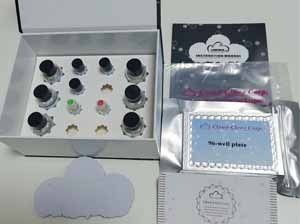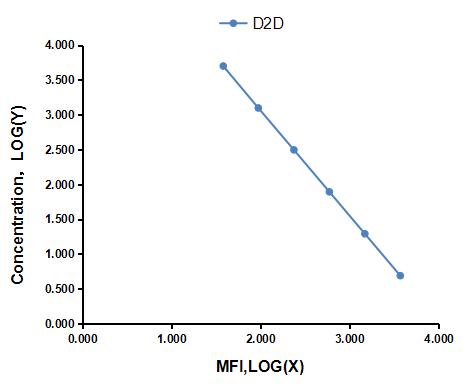Multiplex Assay Kit for D-Dimer (D2D) ,etc. by FLIA (Flow Luminescence Immunoassay) 

D 2 Dimer
(Note: Up to 8-plex in one testing reaction)
- UOM
- FOB US$ 483.00 US$ 502.00 US$ 530.00 US$ 567.00 US$ 604.00 US$ 660.00 US$ 743.00 US$ 929.00
- Quantity
Overview
Properties
- Product No.LMA506Eq
- Organism SpeciesEquus caballus; Equine (Horse) Same name, Different species.
- ApplicationsFLIA Kit for Antigen Detection.
Research use only - DownloadInstruction Manual
- CategoryHematologyCardiovascular biology
Sign into your account
Share a new citation as an author
Upload your experimental result
Review

Contact us
Please fill in the blank.
Recovery
Matrices listed below were spiked with certain level of recombinant D-Dimer (D2D) ,etc. by FLIA (Flow Luminescence Immunoassay) and the recovery rates were calculated by comparing the measured value to the expected amount of D-Dimer (D2D) ,etc. by FLIA (Flow Luminescence Immunoassay) in samples.
| Matrix | Recovery range (%) | Average(%) |
| serum(n=5) | 84-92 | 89 |
| EDTA plasma(n=5) | 79-89 | 86 |
| heparin plasma(n=5) | 92-101 | 96 |
Precision
Intra-assay Precision (Precision within an assay): 3 samples with low, middle and high level D-Dimer (D2D) ,etc. by FLIA (Flow Luminescence Immunoassay) were tested 20 times on one plate, respectively.
Inter-assay Precision (Precision between assays): 3 samples with low, middle and high level D-Dimer (D2D) ,etc. by FLIA (Flow Luminescence Immunoassay) were tested on 3 different plates, 8 replicates in each plate.
CV(%) = SD/meanX100
Intra-Assay: CV<10%
Inter-Assay: CV<12%
Linearity
The linearity of the kit was assayed by testing samples spiked with appropriate concentration of D-Dimer (D2D) ,etc. by FLIA (Flow Luminescence Immunoassay) and their serial dilutions. The results were demonstrated by the percentage of calculated concentration to the expected.
| Sample | 1:2 | 1:4 | 1:8 | 1:16 |
| serum(n=5) | 95-103% | 99-105% | 79-99% | 83-92% |
| EDTA plasma(n=5) | 80-102% | 78-91% | 78-93% | 89-97% |
| heparin plasma(n=5) | 84-95% | 97-105% | 87-101% | 79-90% |
Stability
The stability of kit is determined by the loss rate of activity. The loss rate of this kit is less than 5% within the expiration date under appropriate storage condition.
To minimize extra influence on the performance, operation procedures and lab conditions, especially room temperature, air humidity, incubator temperature should be strictly controlled. It is also strongly suggested that the whole assay is performed by the same operator from the beginning to the end.
Reagents and materials provided
| Reagents | Quantity | Reagents | Quantity |
| 96-well plate | 1 | Plate sealer for 96 wells | 4 |
| Pre-Mixed Standard | 2 | Standard Diluent | 1×20mL |
| Pre-Mixed Magnetic beads (22#:D2D) | 1 | Analysis buffer | 1×20mL |
| Pre-Mixed Detection Reagent A | 1×120μL | Assay Diluent A | 1×12mL |
| Detection Reagent B (PE-SA) | 1×120μL | Assay Diluent B | 1×12mL |
| Sheath Fluid | 1×10mL | Wash Buffer (30 × concentrate) | 1×20mL |
| Instruction manual | 1 |
Assay procedure summary
1. Preparation of standards, reagents and samples before the experiment;
2. Add 50μL standard or sample to each well,
add 10μL magnetic beads,and 50μL Detection Reagent A,incubate 60min at 37°C on shaker;
3. Wash plate on magnetic frame for three times;
4. Add 100μL prepared Detection Reagent B, and incubate 30 min at 37°C on shaker;
5. Wash plate on magnetic frame for three times;
6. Add 100μL sheath solution, swirl for 2 minutes, read on the machine.

Test principle
Analyte-specific antibodies are pre-coated onto color-coded microparticles. Microparticles, standards,Labeled antigen and samples are pipetted into wells and the immobilized antibodies bind the analytes of interest.A competitive inhibition reaction is launched between biotin labeled analytes of interest and unlabeled analytes of interest (Standards or samples) with the pre-coated antibody specific to analytes of interest. Following a wash to remove any unbound substances, Streptavidin-Phycoerythrin conjugate (Streptavidin-PE) is added to each well. A final wash removes unbound Streptavidin-PE and the microparticles are resuspended in buffer and read using the Luminex or Bio-Plex analyzer. The MFI developed is reverse proportional to the concentration of analytes of interest in the sample.
Giveaways
Increment services
Citations
- Determinants of the thrombogenic potential of multiwalled carbon nanotubesScienceDirect: S0142961211004819
- Exogenous Activated Protein C Inhibits the Progression of Diabetic NephropathyPubmed: 22236035
- Protective Effect of Curcumin on Pulmonary and Cardiovascular Effects Induced by Repeated Exposure to Diesel Exhaust Particles in MicePlosOne: Source
- Clinical impact of factor V Leiden, prothrombin G20210A, and MTHFR C677T mutations among sickle cell disease patients of Central IndiaPubmed: 23992124
- Assessment of coagulopathy, endothelial injury, and inflammation after traumatic brain injury and hemorrhage in a porcine modelLww:Source
- Protein S exacerbates alcoholic hepatitis by stimulating liver natural killer T cellsPubmed:25399514
- Systemic and Flap Inflammatory Response Associates with Thrombosis in Flap Venous CrisisPubmed:25448261
- Impact of β-Adrenoceptor Blockade on Systemic Inflammation and Coagulation Disturbances in Rats with Acute Traumatic CoagulopathyPubmed:25676919
- Intraperitoneal administration of activated protein C prevents postsurgical adhesion band formation.PubMed: 25575539
- Procoagulant and Fibrinolytic Activity after Polytrauma in RatPubMed: 26632604
- Upregulation of canonical transient receptor potential channel in the pulmonary arterial smooth muscle of a chronic thromboembolic pulmonary hypertension rat modelPubMed: 26155749
- Trans‐fatty acid promotes thrombus formation in mice by aggravating antithrombogenic endothelial functions via Toll‐like receptorsPubMed: 25546502
- KLF2 and KLF4 control endothelial identity and vascular integrity.pubmed:28239661
- Activated protein C drives the hyperfibrinolysis of acute traumatic coagulopathypubmed:27841821
- Activated TAFI Promotes the Development of Chronic Thromboembolic Pulmonary Hypertension: A Possible Novel Therapeutic Targetpubmed:28289017
- Inhibition of Cell Apoptosis and Amelioration of Pulmonary Fibrosis by Thrombomodulinpubmed:28739343
- Low dose of alcohol attenuates pro-atherosclerotic activity of thrombin.pubmed:28923781
- Lactadherin Promotes Microvesicle Clearance to Prevent Coagulopathy and Improves Survival of Severe TBI Micepubmed:29162596
- Guided longer pulses from a diagnostic ultrasound and intraclot microbubble enhanced catheter-directed thrombolysis in vivo.pubmed:28417266
- Experimental Evaluation of a New Tissue Factor-Based Topical Hemostat (TT-173) for Treatment of Hepatic BleedingPubmed: 30380352
- The Inhibitory Effect of Protamine on Platelets is Attenuated by Heparin without Inducing Thrombocytopenia in RodentsPubmed: 31533230
- Complement factor D is linked to platelet activation in human and rodent sepsis34396466
- NLRP3 Inflammasome contributes to endotoxin-induced coagulationPubmed:35421682
- Construction of a rabbit model with vinorelbine administration via peripherally inserted central catheter and dynamic monitoring of changes in phlebitis and thrombosisPubmed:35126715







